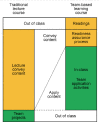Review on the administration and effectiveness of team-based learning in medical education
- PMID: 25804961
- PMCID: PMC8813396
- DOI: 10.3946/kjme.2013.25.4.271
Review on the administration and effectiveness of team-based learning in medical education
Abstract
Team-based learning (TBL) is an active learning approach. In recent years, medical educators have been increasingly using TBL in their classes. We reviewed the concepts of TBL and discuss examples of international cases. Two types of TBL are administered: classic TBL and adapted TBL. Combining TBL and problem-based learning (PBL) might be a useful strategy for medical schools. TBL is an attainable and efficient educational approach in preparing large classes with regard to PBL. TBL improves student performance, team communication skills, leadership skills, problem solving skills, and cognitive conceptual structures and increases student engagement and satisfaction. This study suggests recommendations for administering TBL effectively in medical education.
Keywords: Problem-based learning; Teaching; Team-based learning.
Figures




Similar articles
-
Comparing the effects of team-based and problem-based learning strategies in medical education: a systematic review.BMC Med Educ. 2024 Feb 22;24(1):172. doi: 10.1186/s12909-024-05107-9. BMC Med Educ. 2024. PMID: 38388937 Free PMC article.
-
Team-based learning (TBL) in the medical curriculum: better than PBL?BMC Med Educ. 2017 Dec 8;17(1):243. doi: 10.1186/s12909-017-1068-z. BMC Med Educ. 2017. PMID: 29221459 Free PMC article.
-
Team-based learning, a learning strategy for clinical reasoning, in students with problem-based learning tutorial experiences.Tohoku J Exp Med. 2012 May;227(1):23-9. doi: 10.1620/tjem.227.23. Tohoku J Exp Med. 2012. PMID: 22516766
-
Team-based learning replaces problem-based learning at a large medical school.BMC Med Educ. 2020 Dec 7;20(1):492. doi: 10.1186/s12909-020-02362-4. BMC Med Educ. 2020. PMID: 33287811 Free PMC article.
-
Is team-based learning an alternative approach for UK undergraduate dental education? A scoping review of the literature.Br Dent J. 2024 Jan;236(1):52-56. doi: 10.1038/s41415-023-6615-x. Epub 2024 Jan 12. Br Dent J. 2024. PMID: 38225321 Free PMC article.
Cited by
-
Development and evaluation of a blended learning training programme for pharmacy technicians' continuing education.Eur J Hosp Pharm. 2024 Aug 22;31(5):403-408. doi: 10.1136/ejhpharm-2022-003679. Eur J Hosp Pharm. 2024. PMID: 36898765 Free PMC article.
-
Verification of learner's differences by team-based learning in biochemistry classes.Korean J Med Educ. 2017 Dec;29(4):263-269. doi: 10.3946/kjme.2017.72. Epub 2017 Nov 29. Korean J Med Educ. 2017. PMID: 29207457 Free PMC article.
References
-
- Han JJ. Global doctor's role and outcome-based medical education. Ewha Med J. 2013;36:3–8.
-
- Dent JA, Harden RM. A practical guide for medical teachers. 2nd ed. New York, USA: Elsevier Churchill Livingstone; 2006. Chapter 1, New horizons in medical education; p 2-9.
-
- Parmelee DX. Team-based learning: moving forward in curriculum innovation: a commentary. Med Teach. 2010;32:105–107. - PubMed
-
- MedEdPORTAL [Internet]. Washington, DC, USA: Association of American Medical Colleges; c2013 [2013 October 10]. Available from: http://www.aamc.org/mededportal.
-
- Parmelee D, Michaelsen LK, Cook S, Hudes PD. Team-based learning: a practical guide: AMEE guide no.65. Med Teach. 2012;34:e275–e287. - PubMed
LinkOut - more resources
Full Text Sources
Other Literature Sources

